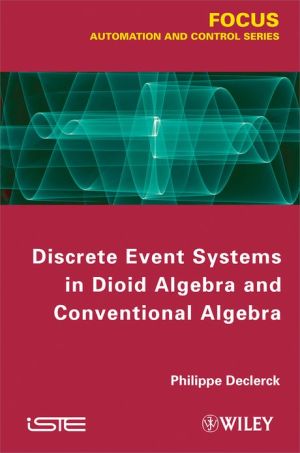

 |

|

Sold Out
Book Categories |
Chapter 1. Introduction 1
1.1. General introduction 1
1.2. History and three mainstays 2
1.3. Scientific context 2
1.3.1. Dioids 3
1.3.2. Petri nets 4
1.3.3. Time and algebraic models 5
1.4. Organization of the book 7
Chapter 2. Consistency 9
2.1. Introduction 9
2.1.1. Models 9
2.1.2. Physical point of view 11
2.1.3. Objectives 12
2.2. Preliminaries 14
2.3. Models and principle of the approach 17
2.3.1. P-time event graphs 17
2.3.2. Dater form 21
2.3.3. Principle of the approach (example 2) 23
2.4. Analysis in the “static” case 25
2.5. “Dynamic” model 28
2.6. Extremal acceptable trajectories by series of matrices 31
2.6.1. Lowest state trajectory 32
2.6.2. Greatest state trajectory 35
2.7. Consistency 36
2.7.1. Example 3 41
2.7.2. Maximal horizon of temporal consistency 44
2.7.3. Date of the first token deaths 47
2.7.4. Computational complexity 48
2.8. Conclusion 50
Chapter 3. Cycle Time 53
3.1. Objectives 53
3.2. Problem without optimization 55
3.2.1. Objective 55
3.2.2. Matrix expression of a P-time event graph 56
3.2.3. Matrix expression of P-time event graphs with interdependent residence durations 57
3.2.4. General form Ax ≤ b 59
3.2.5. Example 60
3.2.6. Existence of a 1-periodic behavior 61
3.2.7. Example continued 65
3.3. Optimization 67
3.3.1. Approach 1 67
3.3.2. Example continued 69
3.3.3. Approach 2 70
3.4. Conclusion 75
3.5. Appendix 76
Chapter 4. Control with Specifications 79
4.1. Introduction 79
4.2. Time interval systems 80
4.2.1. (min, max, +) algebraic models 81
4.2.2. Timed event graphs 82
4.2.3. P-time event graphs 83
4.2.4. Time stream event graphs 84
4.3. Control synthesis 88
4.3.1. Problem 88
4.3.2. Pedagogical example: education system 89
4.3.3. Algebraic models 91
4.4. Fixed-point approach 92
4.4.1. Fixed-point formulation 92
4.4.2. Existence 95
4.4.3. Structure 103
4.5. Algorithm 107
4.6. Example 111
4.6.1. Models 111
4.6.2. Fixed-point formulation 113
4.6.3. Existence 114
4.6.4. Optimal control with specifications 116
4.6.5. Initial conditions 117
4.7. Conclusion 118
Chapter 5. Online Aspect of Predictive Control 119
5.1. Introduction 119
5.1.1. Problem 119
5.1.2. Specific characteristics 120
5.2. Control without desired output (problem 1) 122
5.2.1. Objective 122
5.2.2. Example 1 123
5.2.3. Trajectory description 124
5.2.4. Relaxed system 125
5.3. Control with desired output (problem 2) 127
5.3.1. Objective 127
5.3.2. Fixed-point form 128
5.3.3. Relaxed system 129
5.4. Control on a sliding horizon (problem 3): online and offline aspects 130
5.4.1. CPU time of the online control 131
5.5. Kleene star of the block tri-diagonal matrix and formal expressions of the sub-matrices 132
5.6. Conclusion 138
Bibliography 141
List of Symbols 149
Index 153
Login|Complaints|Blog|Games|Digital Media|Souls|Obituary|Contact Us|FAQ
CAN'T FIND WHAT YOU'RE LOOKING FOR? CLICK HERE!!! X
 You must be logged in to add to WishlistX
 This item is in your Wish ListX
 This item is in your CollectionDiscrete Event Systems in Dioid Algebra and Conventional Algebra
X
 This Item is in Your InventoryDiscrete Event Systems in Dioid Algebra and Conventional Algebra
X
 You must be logged in to review the productsX
 X
 X

Add Discrete Event Systems in Dioid Algebra and Conventional Algebra, This book concerns the use of dioid algebra as (max, +) algebra to treat the synchronization of tasks expressed by the maximum of the ends of the tasks conditioning the beginning of another task – a criterion of linear programming. A classical example is , Discrete Event Systems in Dioid Algebra and Conventional Algebra to the inventory that you are selling on WonderClubX
 X

Add Discrete Event Systems in Dioid Algebra and Conventional Algebra, This book concerns the use of dioid algebra as (max, +) algebra to treat the synchronization of tasks expressed by the maximum of the ends of the tasks conditioning the beginning of another task – a criterion of linear programming. A classical example is , Discrete Event Systems in Dioid Algebra and Conventional Algebra to your collection on WonderClub |